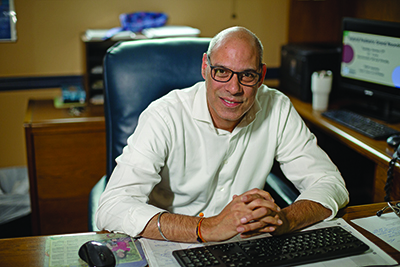Most ‘holes in the heart’ treatable with children
Watch baby/tot eating habits

Based upon “a natural history study” from a few years ago, “the incidence of congenital heart disease is 8 per 1,000 life births,” said Dr. Sumeet Sharma, director of Pediatric Cardiology at East Tennessee Children’s Hospital. “And it ranges from something significant to be treated immediately after birth to those that we just follow to see how they progress.”
Holes in the heart
Among the most common heart problem with infants and younger children are “holes in the heart,” Sharma said about defects involving the wall or vessels of the heart. “There are ASD (atrial septal defect), VSD (ventricular septal defect) and PDA (patent ductus arterioles).”
Though perhaps sounding like a life and death matter, such “holes in the heart” have varying degrees of seriousness — and the vast majority are treatable.
“There are some holes in the heart that we just follow, some that require surgery and some that require medications for management,” Sharma said. “So it all varies on the severity of the exact lesion.”
As for making a full recovery if discovered and treated in a reasonable amount of time, “most of these kids do very well,” Sharma said. “… Yeah, most of them are absolutely fine. Granted, they may need some medication, they may need surgery. But most kids, after their surgery, if the hole is closed, they make a pretty darn near normal recovery.”
In fact, “patients that have had heart surgery as infants and children are playing basketball at our local high schools and have gone on to successful careers with medicine and beyond,” he added.
Possible symptoms
As for what symptoms to be aware of that might indicate a heart issue, “It all depends upon the age of the child,” Sharma said. “Little babies will have difficulty eating with formula and take a long time to eat.
“A baby’s version of exercise is eating, so if they’re struggling eating and they’re not gaining weight, that’s the bad sign,” he added.
Other signs include “obviously turning blue, unusual flushness or irritability, which you can’t account for, things like that,” Sharma said. “Lethargy, decreasing exercise tolerance.”
He or she “used to be the fastest kid in the class, now you’re the slowest kid in the class,” he added. “You just can’t keep up. So exercise and tolerance or decreased endurance and stamina.”
Dental health and
young hearts
“If you have a heart defect that requires surgery and you have poor dental health, there is an increased risk of an infection in that population,” Sharma said.
Although pointing out “dental health has been shown to be associated with endocarditis or an infection of the heart muscle” in the overall population, he added, “for the general child who has an otherwise healthy heart, poor dental hygiene is not as serious as as an adult.
“But once again, if you have good dental hygiene as a child, that will carry on into adulthood.”
Trends, advanced treatment
“Most of the heart defects that they encounter in pediatrics is (infants and children) are born with the heart defects, as opposed to adults, where they develop over the course of several decades,” Sharma said. “The ones that you are not born with are infection of the heart muscle that can cause heart failure or something called kawaski disease, inflammation.”
Overall with infants and children concerning heart problems, “With the new surgeries that we’re doing, with the advancements in technology and procedures, a lot of our kids that used to die during infancy are living into adulthood,” Sharma said, also pointing to “advances in medicine that has helped these children from a cardiac standpoint.”
Preventative steps
While family history also has to be considered when evaluating an infant/child’s heart health, “I think it never hurts to start early” in terms of proper nutrition, exercise and regular check-ups, Sharma said. “The later you start, the harder it’s going to be. We all know it’s hard to change as an adult, but it’s easier to change someone as a child. When you’re set in your ways, it’s harder to change.
“But you also have to be able to live a little — you’re allowed to have candy, but not for breakfast, lunch and dinner,” he said. “But have it be the exception, or a treat, as opposed to the norm.”
Final thoughts
“I think your adult heart disease is a function of your family history and lifestyle choices,” Sharma said. “If you make the concerted effort to eat healthy as a child … I think you’ll just help your heart health in the long term.”
The ETCH official concluded with a simple piece of advice for young parents: “The earlier you start investing in your health, the more dividend is going to pay off in the future.”


